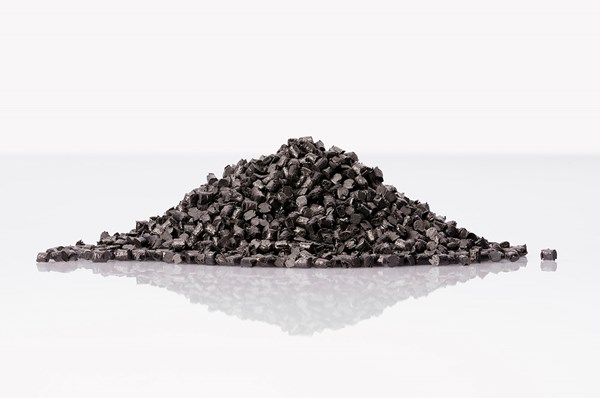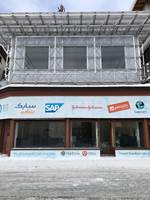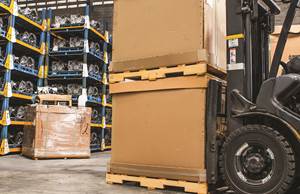No News Shortage on Thermoplastic Composites at JEC World 2017
Sabic enters continuous carbon-fiber reinforced tape; TxV taps Fiberforge technology; Xenia introduces materials reinforced with hybrid (glass/carbon) fillers; and more.
Particularly over the last few years, new developments in thermoplastic composites have continued to impress at the big international JEC composites show in Paris. A variety of players continue to grow and/or newly emerge in this promising and strong growth arena. Here are just a handful of highlights in thermoplastic composites from JEC World 2017, held March 14-16.
● SABIC: The company has expanded its Udmax range of continuous fiber thermoplastic tape portfolio. The new materials are Udmax GPE—glass-fiber-reinforced polyethylene and Udmax CPA—carbon-fiber-reinforced nylon, and they signal SABIC's entry into the continuous carbon-fiber-reinforced tape arena. SABIC’s FRT business leader Andrey Turchin heralds their unique mechanical properties which enable the production of stiffer, stronger and more lightweight parts that can be used in a variety of applications. These include pipe, pressure vessels, and sporting goods.

The company also displayed a roll of its Udmax-GPP (glass-reinforced-polypropylene) tape which is over 6500 feet in length, and also presented, for the first time, material forms made out of Udmax GPP 45-7- tape: plain-woven and cross-piled (0/90) material. These are material forms that are gaining interest in the manufacture of lightweight thermoplastic (sandwich) panels for the transportation and building and construction markets thanks to their excellent stiffness, strength and impact resistance. As previously reported, this and other SABIC technologies were used in the ICEhouse—the iconic structure designed by architect William McDonough and built at the World Economic Forum in Davos, Switzerland.
● Dieffenbacher (Dieffenbacher North America Inc., Alpharetta, Ga.): The company announced that its new Fiberforge tape-laying system will be used by TxV Aero Composites—a joint venture of Victrex (Victrex USA Inc., Conshohocken, Penn.) and Tri-Mack Plastics Manufacturing Corp., Bristol, R.I. As previously reported, the two partners recently formed this venture in order to deliver PAEK composite solutions on a large-scale basis for the commercial aerospace industry.
Applications include loaded clips and brackets, interiors and seating among other commercial aircraft applications. To enable this goal, TxV Aero Composites opted to use the new Fiberforge tape laying system from Dieffenbacher. This in recognition that in order to meet the cost challenges and high-volume production demand, the thermoplastic composite manufacturing process needs to be highly efficient with short cycle times. The Fiberforge system is reportedly the world’s fastest tape-laying system. “It requires less than one second per course integrated with downstream systems such as the handling robot and forming press—more than one million parts can be manufactured per year on just one line,” said Dieffenbacher sales director Markus Geier.
Fiberforge creates flat, net-shape engineered laminates from continuous glass- or carbon-fiber tapes. This system can handle up to four different tape materials in the one production run. The complete production process is fully automated, including an automated spool-changing system that enables uninterrupted production. Using continuous fiber tapes minimizes the high cost of waste typically associated with lay-up from fabric materials while concurrently producing lighter laminates with 10-30% higher structural performance than weave-based laminates. Overall, this new approach will deliver cost savings compared to metal or traditional composites.
● Xenia of Italy introduced a new family of materials reinforced with hybrid fillers composed of carbon and glass fiber mixtures. The Xebrid family of thermoplastic composites includes variable percentages of the reinforcements within different polymer matrices, allowing users to obtain a wide range of physical-mechanical properties depending on the selected type of application. The company sees this family of materials as ideally suited to all applications where metal replacement is required to optimize cost performance and process technologies—industrial and agricultural equipment, construction, and oil and gas. Xenia also sees these advantages applied to applications where lightweightness along with mechanical properties and processability are required—sporting equipment, transportation, aeronautics.

Two years ago at JEC, Xenia and global player in LFT compounds and technologies PlastiComp, Inc., Winona, Minn, announced their strategic partnership to develop applications for carbon fiber thermoplastic composites. Under this agreement, Xenia has been developing solutions based on PlastiComp’s complet long carbon fiber reinforced thermoplastic composites—available with 15-50% carbon fiber in thermoplastic polymers from PP to PEEK, and Xenia’s Xecarb shot carbon fiber reinforced thermoplastic composites (TPEs, nylon, PPS, PPA, PEEK) for the European market. Meanwhile, PlastiComp has developed its own line of hybrid composites that combine long glass and carbon fiber together into a single ready-to-mold pellet.
● Japan’s Toho Tenax Co. (U.S. office in Rockwood, Tenn.): This core company of Teijin Group’s carbon fibers and composites business, highlighted a new compound based on recycled thermoplastic carbon fiber material and PEEK, which was developed by its German subsidiary Toho Tenax Europe. In conjunction with its partners, an OEM aircraft manufacturer and aerospace parts manufacturer Sintex NP Group, the company demonstrated that a serial aircraft wing access panel could be manufactured, proving the performance of the recycled granules. The closed-loop-concept from production residues via Tenax-E Compound to final part was the awarded winner at JEC Asia 2016 in the category “Recycling”.

The Tenax E-Compound rPEEK CF30 is a reinforced material combination of waste materials generated during processing of Tenax thermoplastics and recycled semi-crystalline PEEK polymer, which contains 30% of carbon fiber by weight and offers a high performance in strength and stiffness for injection molding applications. The compound boasts a nearly identical performance to virgin standard material in terms of tensile modulus and strength, which also included elongation, viscosity, chemical resistance, abrasion resistance, and a very low-moisture absorption ratio, to round off the key characteristics of this recycled material. According to the company, the created value of this compound is linked to the combination of high performance materials as well as low-cost price of 40-60% compared to virgin carbon fiber reinforced PEEK compounds.
Related Content
Prices for All Volume Resins Head Down at End of 2023
Flat-to-downward trajectory for at least this month.
Read MoreThe Fantasy and Reality of Raw Material Shelf Life: Part 1
Is a two-year-old hygroscopic resin kept in its original packaging still useful? Let’s try to answer that question and clear up some misconceptions.
Read MorePrices of Volume Resins Generally Flat or Lower
Exceptions in early March were PP and PS, which moved up solely due to feedstock constraints, along with slight upward movement in PVC and PET.
Read MorePrices Bottom Out for Volume Resins?
Flat-to-down trajectory underway for fourth quarter for commodity resins.
Read MoreRead Next
Victrex Expands Its “Downstream” Parts Manufacturing Business
The joint venture with Tri-Mack Plastics to accelerate use of PAEK composite components in aerospace.
Read MoreThermoplastics Composites Featured in SABIC’s ICEhouse
Innovative structure at 2017 World Economic Forum combined advanced technologies and design.
Read MorePlastiComp and Xenia To Develop Apps For Carbon Fiber TP Composites
At JEC Europe 2015, PlastiComp and Italy's Xenia announced partnership to advance applications of carbon fiber reinforced TP composites.
Read More


























